Microeconomics Study Guide
Elasticity of Demand
Price Elasticity of Demand Calculation
Tolls on the Powhite Parkway increases from $0.50 to $0.70, traffic decreases from 8,000 to 5,000 trips per day. Assuming all the changes in quantity were due to the change in the toll, what is the price elasticity of demand for the Powhite Parkway?
{`
P0 = $0.5 , P1 = $0.7
Change in Price = ∆P = P1 - P0 = $0.2
Q0 = 8000 , Q1 = 5000
Change in Quantity demanded = ∆Q = Q1 -Q0 = -3000
Price elasticity of demand = (Change in Quantity demanded)/(Change in Price)*P0/Q0
= ∆Q/∆P * P0/Q0
= - 0.9375
`}
Since the absolute value of the elasticity of demand is less than 1, this implies the demand is inelastic. Thus, the price elasticity of demand for the Powhite Parkway is inelastic.
Price calculations based on Price Elasticity of Demand formula
What will be the percentage change in price in the following instances?
a. Demand shifts to the right by 10%, elasticity of demand is 1, and elasticity of supply is 2.
{`
Percentage change in quantity demanded= 10%
Elasticity of demand= -1 (because of inverse relationship in price and quantity demanded)
Elasticity of demand= (percentage change in quantity demanded)/(percentage change in price)
-1 = 10/(percentage change in price)
percentage change in price = -10%
Thus, the price falls by 10%
`}
b. Demand shifts to the left by 10%, elasticity of demand is 0.2, and elasticity of supply is 0.5.
{`
Percentage change in quantity demanded= -10%
Elasticity of demand= - 0.2 (because of inverse relationship in price and quantity demanded)
Elasticity of demand= (percentage change in quantity demanded)/(percentage change in price)
-0.2= (-10)/(percentage change in price)
percentage change in price = 50%
Thus, the price increases by 50%
`}
c. Supply shifts to the right by 25%, elasticity of demand is 3, and elasticity of supply is 2.
{`
Percentage change in quantity supplied= 25%
Elasticity of supply= 2
Elasticity of supply = (percentage change in quantity supplied)/(percentage change in price)
2= 25/(percentage change in price)
percentage change in price = 12.5%
Thus, the supply price increases by 12.5%
`}
Shifts of Production possibility Frontier
If an economy’s production possibility curve shifted to the right, this would illustrate Economic growth. Economic growth leads to an increased capacity of the economy to produce higher amounts of all goods and services. This leads to a rise in the output of the all goods produced causing a rightward shift in the Production Possibility frontier. When a country is struck by a natural disaster, the production possibility curve shifts inwards as natural disaster destroys the productive capacity of the economy and leads to a decline in the quantity of overall output produced. The concave shape of production possibility frontier depicts the increasing opportunity costs of one good in terms of another. If an economy is operating at a point below its production possibility frontier, it depicts Unemployment. This means that all the productive capacity of the economy is not being fully utilised in the production process and thus the economy can do better by increasing production of all goods and services and utilise the excess capacity.
Stock and Flow Variables
A flow variable is the one which is measured with reference to a period of time. That is a flow variable requires a time specification such as years, quarters, months etc. For example National Income is a flow variable. It describes the flow of total goods and services produced in a country within a year. Other flow variables include gross domestic product investment, expenditure, savings, interest, exports, imports, population growth and many others that are measured over a period of time.
A stock variable is a quantity which is measurable at a particular point of time such as on 1st December, Friday, 2016, etc. Wealth is a stock variable. On a particular date (say, 1st April, 2016), a person owns and commands a given value of wealth holdings and assets. Thus a stock variable has a reference time point but no time dimension (length of time). as against a flow which has time dimension.
Examples of stock variables are Capital, wealth and money supply. This is because the capital, wealth and money supply are measured at a point of time and not over a period of time. Unemployment is a stock measure not a flow measure. It is the total number, a proportion of the labor force at a point in time.
Microeconomics studies topics such as Factors that influence the price of potatoes. Microeconomics does not deal with the economy as a whole. Under Macroeconomics we study topics such as Factors that determine inflation, Determinants of total income, whether Unemployment rate will rise or fall.
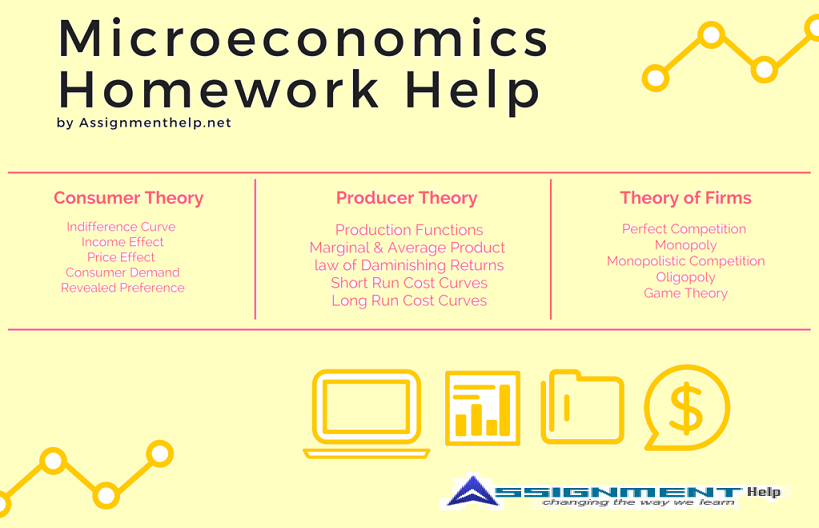
Monopoly
Explain using graphs how monopoly is less efficient than perfect competition.
Under perfect competition market, firms have no market power making it the most efficient market structure while the monopolist has the highest market power making it the least efficient market structure.
The following diagram shows the long run equilibrium for a perfectly competitive firm and industry.
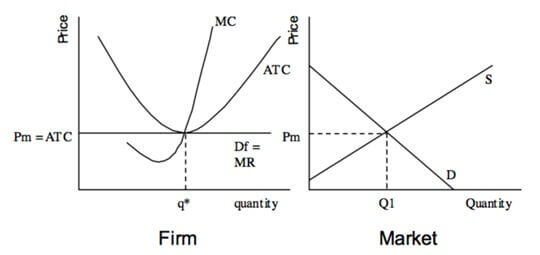
The following diagram shows the longrun equilibrium for a monopolist.
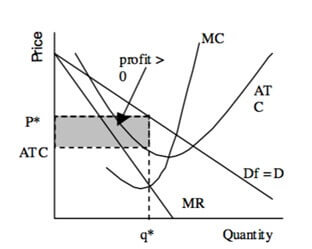
Under perfect competition, the firm, being the price taker does not have have any control over the price and it has to accept the price determined by the industry. Thus, the firm reaches its long run equilibrium at the level where MC = MR = AR; thereby not eaning any supernormal profits.
On the other hand, monopolist is the price maker and in the long run, he reaches an equilibrium at thet level where MC=MR and the P is higher than this level. Thus, the monopolist will earn supernormal profits in the long run.
There is productive efficiency in the perfect competition market as all the firms produce at the mnimum point of the ATC curve while in the monopoly, the firm produces where Price > ATC. Thus, monopoly is characterized by productive inefficiency.
Similarly, monopoly also has allocative inefficiency as it does not produce wher price equals MC. Rather, a monopolist sells where price is greater than the marginal cost, thereby earning profits. Perfectly competitive firm produces where MC equals MR which equals the price. Thus, it has allocative efficiency.
Therefore, it can be concluded that the monopoly market structure is less efficient than perfect competition.
Why is MR less than price in a monopolistic market?
Since the monopolist is the sole seller, the demand curve he faces is actually the market demand curve which is downward sloping. The MR curve lies at the mid point of the demand curve and y-axis as the MR falls at twice the rate of the fall in AR (or demand). The monopolist produces at that level where MC equal MR, but at this level, the AR is higher than the MR. The price is determined at that level where the equilibrium quantity intersects the demand curve. Therefore, the monopolist earns profits as shown in the shaded region in the diagram.
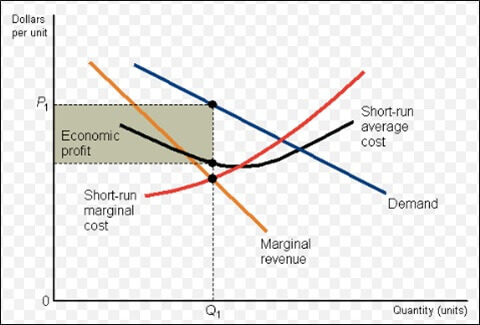
A recent report shows that cars made in Canada are sold at lower prices in the U.S. Although they do not have a monopoly, how would price discrimination help to explain this. What does it say about Canadian consumers relative to those in the U.S? [5]
Cars made in Canada are sold at higher prices in Canada and at lower prices in USA. Although the car production market is not a monopoly, this factor can be explained by the multi-market price discrimination strategy. Under this strategy, the firm differentiates among different segments of consumers and sets different selling prices for each segment based on the elasticity of demand in these markets.
This can be explained with the given diagram.
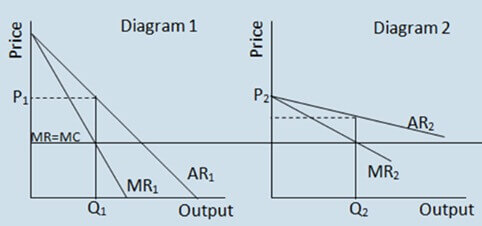
Diagram 1 shows the demand in the Canadian markets. Here, the demand is less elastic, i.e., the consumers are not likely to reduce the demand for cars by a great extent due to high prices. Therefore, in such a market, the producers can charge higher prices.
The Diagram 2 shows the demand for cars in the markets of USA. Here, the demand is more elastic. This means that the consumers are sensitive of price change and a increased price of cars will drastically reduce its demand. Therefore, in such a market, the producers charge a lower price.
Therefore, the concept of costlier cars in Canada can be attributed to this aspect of elastic and inelastic demands under price discrimination.
The different elasticities show that the consumers in the USA are more sensitive to the changes in prices of cars than the consumers in Canada. Canadian consumers are easily willing to pay more for cars, but those in USA might not demand cars in similar quantities if the price increases.
d) Give an example of a monopoly. Briefly explain whether you believe it should remain as a monopoly or not. Support your answer.
A prominent example of a natural monopoly is the water supply industry. Generally, the water supply is owned by the government and no private players are present in the industry. A single firm operates within this industry because of the huge average fixed costs involved in terms of establishing water treatment plant and laying if the water supply pipes by each firm in the industry.
Therefore, only one firm should ideally operate in this industry (i.e., a natural monopoly should prevail). Since water is a basic necessity, it has to be made available to all at an affordable price. More than 1 player in the industry would mean high average costs for all the firms. As a results, the cost of supplying water per unit will rise and the firms will operate at the rising portion of the ATC curve. On the other and, if only 1 firm operates, it will be able to cover the high fixed costs even while supplying at a reasonable price as it will benefit from Brand Management Tutors. This is because it will be the only one responsible for the entire supply of water while if there will be more than 1 firm, they will compete in terms of Brand Management Tutors and thus, the benefits of large scale production will not be available. Therefore, a monopoly will ensure that water supply is maintained relatively lower prices.
Thus, it is better if a natural monopoly like that of water supply continues the way it is.
Perfect Competition
a) Explain three ways in which international currency markets fit our model of perfect competition. Make sure to explain the effect of the assumptions in the currency market. [6]
The goods traded in currency exchange markets are homogenous - a Canadian dollar is a dollar whether someone is trading it in London, New York or Toronto.
All the major banks around the world have foreign exchange trading floors where buyers and sellers operate internationally.
Currency exchanges are open twenty-four hours a day. Technological progress in communications means that traders around the world (buyers and sellers) have real time information and also plenty of background analysis on the factors driving the prices of each individual national currency.
The currency market (commonly knowm as the forex market) is closelt related to a perfect competition market structure. This can be substantiated on the basis of the following features of the competitive markets which are present in the forex market.
1. Under perfect competition, the goods are homogeneous and the consumers do not differentiate among the goods of various sellers. Similarly, the players in the currency market also do not differentiate among the currency being traded. For example: a Canadian dollar is a dollar whether someone is trading it in London, New York or Toronto. Thus, the currency market fulfils this feature of a competitive market.
2. Under perfect competition, the number of market players (buyers and sellers) is large. Similarly, under the currency market, there are very large number of players involved at an international level. There are several buyers and sellers of forex who trade freely at the platform.
3. Under perfectly competitive market, the buyers have perfect knowledge about the price prevailing in the market and the sellers also have perfect knowledge about the production techniques to be used. Similarly, with the advancement in technology and communication systems, the players of the forex market around the globe have perfect knowledge about any recent market developments, historical prices, factors influencing currency prices, and nay other relevant data that may be required by them. This ensures that the playes in the market have perfect knowledge about all market related data.
All these elements of the currency market make it similar to the perfect competition market structure.
b) If a firm’s cost of manufacturing a good (fixed and variable costs) is equal to the revenue it makes from selling the good is it making an economic loss or a normal profit – explain.
When the firm’s total costs and the total revenue are equal, the firm will break even.
In the following diagram, at points K and M, the firms Tc curve intersects the TR curve. At this point, the firm is able to cover all its fixed and variable costs but does not earn more than the costs. Thus, the firm does not make profits or earn losses. It breaks even at this level. If TC > TR (the range before point K and beyond point M), the firm is unable to cover costs and thus incurs losses. When TR > TC, the firm earns more than what it soends and thus, it is in profits. Therefore, the point where TR= TC is the break even point.
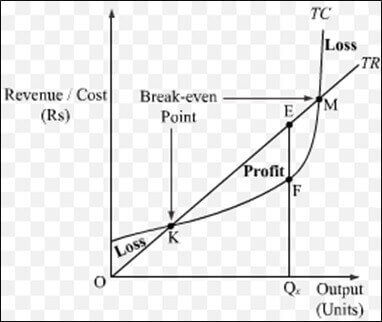
c) Why will a firm always produce where MC = MR?
A firm reaches its equilibrium at that level where MC equals MR (only if MC exceeds MR beyond that level). When the MC < MR, the firm is incurring profits, but, the firm also has the possibility to increase these profits by producing more. Therefore, in expectation of higher profits, the firm will never curtail its production to the level where MC is less than MR. on the other hand, when MC > MR, the firm will not undertake production of that unit because the additional cost toproduce that unit is greater than the revenue ontained from its sale.
Therefore, a competitive firm will always produce at that level where MC equals MR.
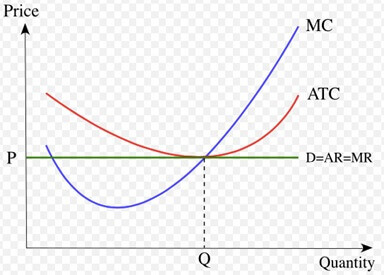
Need help with Microeconomics Course?
Microeconomics is the study of individual level decisions of consumers and producers, keeping all other factors as fixed. Microeconomics covers topics such as demand and supply analysis, consumer theory, producer theory, cost theory and cost curves, theory of firms, various types of market structures such as perfect competition, monopoly, monopolistic competition, oligopoly, oligopolistic competition. Market imperfections are covered under topics of externality, public goods and adverse selection and asymmetric information.
If you are looking for help with principles of microeconomics homework, get in touch with our online microeconomics tutors. At assignmenthelp.net we offer microeconomics homework help with principles of microeconomics, intermediate microeconomics as well as advanced microeconomics. Microeconomics help is available with online study notes, solved example problems on important formula of consumer theory, producer theory as well as theory of market structures. Our economics tutoring faculty can help with Profit maximization problems based on perfect competition, monopoly, monopolistic competition and oligopoly or any other conceptual problem based on microeconomics such as adverse selection, asymmetric information and even comparative static analysis on demand/supply/indifference curve analysis.


